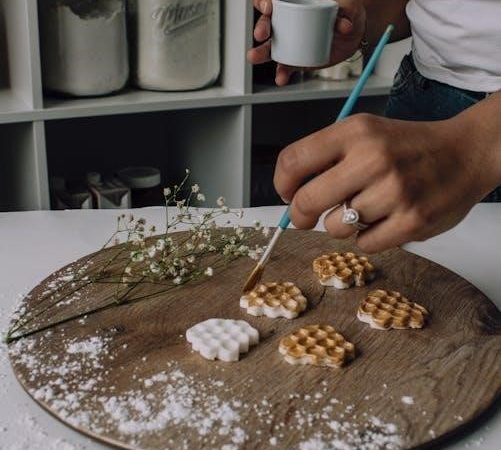boil mouthguard instructions

Boil-and-bite mouthguards are moldable dental protectives used in sports, offering a balance between affordability and custom fit. They provide excellent protection and comfort for teeth and gums.
1.1 What Are Boil-and-Bite Mouthguards?
Boil-and-bite mouthguards are moldable protective devices made from thermoplastic material. They are designed to be softened in boiling water, allowing users to shape them by biting down, creating a custom fit. These mouthguards are commonly used in sports, martial arts, and for teeth grinding at night. They offer a cost-effective alternative to custom-fitted mouthguards while providing good protection for teeth and gums. The material softens when exposed to heat, enabling it to conform to the user’s dental structure for a secure and personalized fit. They are widely available and popular for their ease of use and affordability compared to professional dental options.
1.2 Benefits of Using a Boil-and-Bite Mouthguard
Boil-and-bite mouthguards offer several advantages, including excellent protection for teeth and gums during sports or nighttime grinding. They provide a custom fit at a lower cost than professionally made mouthguards. The moldable material ensures a secure and comfortable fit, reducing the risk of dental injuries. These mouthguards are widely available, making them a convenient option for athletes and individuals with bruxism. Their ease of use and affordability make them a popular choice for those seeking reliable dental protection without the need for a dentist’s intervention. They strike a balance between protection, comfort, and accessibility, making them a practical solution for many users.

Preparing for the Boiling Process
Gather materials like a saucepan, slotted spoon, and bowl of ice water. Choose the correct size and clean the mouthguard before boiling for proper fitting.
2.1 Gathering Necessary Materials
To prepare for boiling, gather essential items: a saucepan, water, a slotted spoon, a bowl of ice water, a mirror, and a timer. These tools ensure proper softening and shaping of the mouthguard. The saucepan is used to boil water, while the slotted spoon helps submerge and retrieve the mouthguard safely. Ice water is crucial for cooling the mouthguard after boiling to set its shape. A mirror allows visibility while fitting, and a timer ensures the correct boiling and cooling durations are followed. Having all materials ready streamlines the process and prevents delays.
2.2 Choosing the Right Size and Shape
Selecting the correct size and shape ensures a proper fit and optimal protection. Common sizes include youth, adult, and strapped versions, catering to different mouth sizes. Choose a mouthguard that covers all teeth without extending beyond the gumline for comfort and to prevent irritation. Consider the thickness for specific sports requirements. Ensure the shape aligns with your dental structure for a snug fit. Proper sizing prevents discomfort and ensures the mouthguard stays in place during activity. Tailor your choice to individual needs, such as dental work or braces, for the best results.
2.3 Cleaning the Mouthguard Before Boiling
Cleaning the mouthguard before boiling is essential for hygiene and proper fit. Use mild soap and warm water to gently scrub all surfaces, removing any dirt or packaging residue; Rinse thoroughly to ensure no soap remains. Pat dry with a clean cloth to prevent water spots. Avoid harsh chemicals or abrasive materials that could damage the material. A clean mouthguard ensures better adhesion during the boiling process and promotes a secure, comfortable fit.
Boiling the Mouthguard
Fill a saucepan with water, bring to a rolling boil, then carefully submerge the mouthguard to soften it for proper shaping and fitting.
3.1 Filling the Saucepan with Water
Filling the saucepan with the correct amount of water is essential for boiling the mouthguard. Use a saucepan deep enough to hold 3 to 4 inches of water, ensuring the mouthguard can be fully submerged. Fresh, clean water is recommended to prevent contamination. Avoid adding salt or other additives, as they may alter the boiling temperature or damage the mouthguard material. Proper water level ensures even heating and prevents the mouthguard from sticking to the pan. Once filled, place the saucepan on a stove over high heat to bring the water to a rolling boil before proceeding.
3.2 Bringing Water to a Rolling Boil
Place the saucepan with water on a stove over high heat. Monitor the water closely as it heats. A rolling boil is achieved when bubbles rise rapidly and continuously to the surface. Avoid leaving the stove unattended, as the water can quickly reach a boil and potentially overflow. Once the water reaches a steady, vigorous boil, reduce the heat slightly to maintain a consistent boil. Ensure the water remains at a rolling boil for the recommended time before proceeding to submerge the mouthguard. This step is crucial for softening the material properly.

Fitting the Mouthguard
After boiling, carefully place the softened mouthguard in your mouth, aligning it with your upper teeth. Gently bite down to shape it around your teeth and gums, ensuring a snug fit. Hold in place until it cools slightly to set the shape. If needed, submerge it briefly in boiling water again for adjustments. Proper fitting ensures comfort and protection during use.
4.1 Submerging the Mouthguard in Boiling Water
To begin fitting, carefully place the mouthguard into the boiling water using a slotted spoon or tongs. Ensure it is fully submerged. Allow it to soften for 30-60 seconds, depending on the manufacturer’s instructions. Once the material feels pliable but not overly soft, use the spoon to remove it from the water. Be cautious, as the mouthguard will be hot. Proper submersion ensures even softening, which is essential for achieving a precise fit. Avoid leaving it in for too long, as this could cause the material to become misshapen or brittle. Timing is key to a successful fit.
4.2 Placing the Mouthguard in the Mouth and Shaping
Immediately after submerging, carefully place the softened mouthguard into your mouth, aligning it with your natural bite. Bite down gently but firmly to press the material against your teeth and gums. Use your fingers or thumbs to apply pressure, ensuring the edges mold snugly around your teeth and jawline. Hold this position for 10-15 seconds to set the shape. Once removed, submerge the mouthguard in ice water to cool and harden. This step ensures a secure, customized fit tailored to your mouth’s contours. Proper shaping is essential for comfort and protection during use.

Cooling and Setting the Mouthguard
After boiling, transfer the mouthguard to ice water to cool and harden, ensuring a snug fit and lasting protection for your teeth and gums.
5.1 Transferring the Mouthguard to Ice Water
Immediately after boiling, carefully transfer the mouthguard to a bowl of ice water using a slotted spoon. This step stops the cooking process and allows the mouthguard to cool down. Submerge it completely in the ice water to ensure proper cooling and hardening. The ice water helps the mouthguard retain its shape and ensures a snug, secure fit once it has cooled. Avoid leaving it in the ice water for too long, as this could make the material too stiff. Let it sit just until it has firmed up enough to handle without distortion.
5.2 Allowing the Mouthguard to Cool and Harden
Once the mouthguard is submerged in ice water, let it sit undisturbed for 1-2 minutes to fully cool and harden. This step is crucial as it ensures the material firms up properly, retaining the shape molded to your teeth. After cooling, carefully remove the mouthguard from the ice water and gently pat it dry with a clean cloth. It is now ready to test for fit. Avoid skipping this step, as the mouthguard must be completely hardened to provide a secure and comfortable fit during use.

Testing the Fit
After cooling, place the mouthguard in your mouth to ensure a snug, secure fit. Check for comfort and proper alignment, ensuring it stays in place without shifting.
6.1 Checking for Comfort and Security
After cooling, carefully place the mouthguard in your mouth to assess its fit. Ensure it feels comfortable and secure, with no shifting or movement. Check that it aligns properly with your teeth and gums, providing even coverage. Pay attention to any areas of discomfort or pressure, as these may indicate improper shaping. The mouthguard should stay firmly in place without causing difficulty in speaking or breathing. If it feels too tight or loose, adjustments may be necessary. A proper fit ensures optimal protection and performance during activities.
6.2 Adjusting the Fit if Necessary
If the mouthguard feels too loose, submerge it in boiling water for a few seconds, then reshape it by gently pressing the walls with your thumbs while it’s in your mouth. For a tighter fit, repeat the boiling process for 5-10 seconds and refit. If the mouthguard feels too tight, carefully trim excess material with scissors, ensuring not to remove too much and compromise protection. Always test the fit again after adjustments to ensure comfort and security. Proper adjustments ensure the mouthguard stays in place during activities, providing optimal protection without causing discomfort or restriction.
Troubleshooting Common Issues
If the mouthguard feels too loose, re-submerge it in boiling water for a few seconds and reshape. For a tighter fit, trim excess material carefully with scissors.
7.1 What to Do if the Mouthguard Feels Too Loose
If the mouthguard feels too loose, re-submerge it in boiling water for 5-10 seconds. Remove it with a slotted spoon and gently press the walls with your thumbs while it’s still warm. Bite down firmly to reshape it around your teeth. If it still feels loose, repeat the process briefly. Ensure not to over-submerge, as this may distort the shape. Once reshaped, immediately transfer it to ice water to set the new form. This method helps achieve a snug, secure fit without compromising comfort or protection.
7.2 What to Do if the Mouthguard Feels Too Tight
If the mouthguard feels too tight, it may have been over-submerged in boiling water or shaped too aggressively. To fix this, ensure the boiling time aligns with the brand’s recommendations, typically 30-60 seconds. Avoid excessive pressure during shaping; instead, gently mold it around your teeth. If it remains too tight, consider shortening the boiling duration next time to prevent excessive softening. After shaping, promptly transfer it to ice water to set the form, ensuring a snug yet comfortable fit without unnecessary tightness.
Maintenance and Care
Regularly clean the mouthguard with mild soap and water. Store it in a dry, ventilated container to prevent bacteria growth. Avoid harsh chemicals or extreme temperatures.
8;1 Cleaning the Mouthguard After Use
Cleaning your boil-and-bite mouthguard is essential for maintaining hygiene. Use mild soap and warm water to gently scrub the surface. Rinse thoroughly with clean water to remove any residue. Avoid harsh chemicals or abrasive materials that could damage the material. For tougher stains, mix equal parts water and vinegar and soak the mouthguard for 10 minutes before rinsing. Regular cleaning prevents bacteria buildup and ensures a fresh fit. Always dry the mouthguard completely before storing it to avoid mold growth.
8.2 Storing the Mouthguard Properly
Proper storage is crucial for maintaining your boil-and-bite mouthguard’s quality. Always keep it in a protective case when not in use to prevent damage. Ensure the mouthguard is completely dry before storage to avoid mold growth. Avoid exposing it to direct sunlight or extreme temperatures, as this can alter its shape. Store it in a cool, dry place, away from pets and children. Regularly inspect the case for cleanliness and replace it if damaged. Proper storage extends the lifespan of your mouthguard and ensures it remains hygienic and effective for future use.





